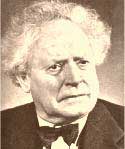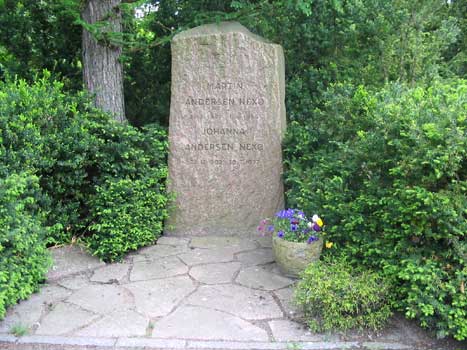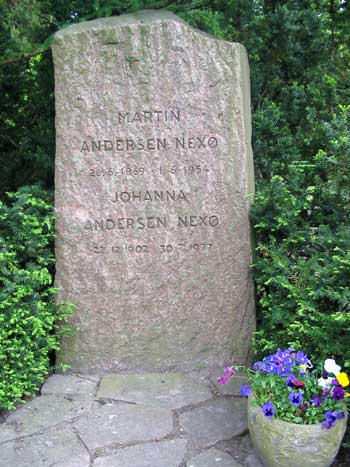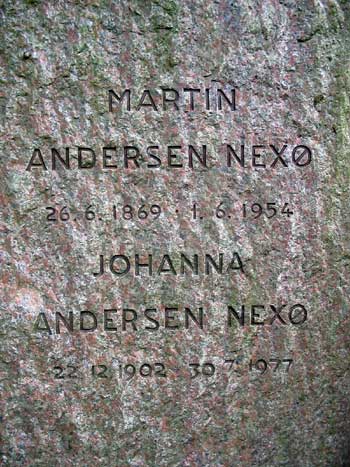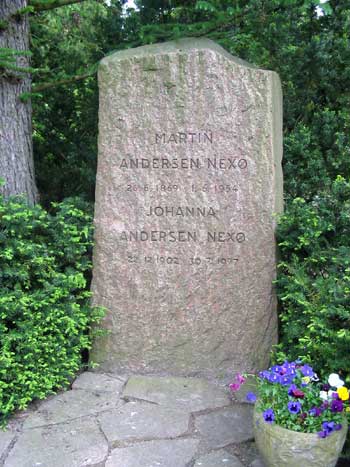|
Martin Andersen-Nex° was born in the slums of Copenhagen into extreme poverty. He was the fourth of eleven children. His father, a stone mason, was an alcoholic and his mother, Mathilda Mainz, was a daughter of a German blacksmith. When he was eight, the family moved to the town of Nex° on the island of Bornholm, whose name he adopted in 1894 as his own. With the help of a patron Nex° was able to go to school. In his youth he worked as a farmhand, shepherd, shoemaker's apprentice, and mason's assiatant on the island of Bornholm. Between the years 1894 and 1896 he traveled in Spain and Italy, where he was an apprentice to a cobbler. In Denmark he worked as a hod-carrier and general laborer. During this time he became a socialist. After studying two years at the Askov Folk High School, Nex° graduated as a teacher in 1897 and found work at a Gruntvigian folk school in Odense. His first collection of stories, SKYGGER (1898) dealt with the world of the destitute. Along with the modest success of FAMILIEN FRANK (1901) he gave up teaching and devoted entirely to writing. DRYSS (1902) echoed fin de siŔcle pessimism but SOLDAGE (1903) expressed the author's faith in the working class. His breakthrough work, PELLE EROBEREN (4 vols.), appeared between in 1906-1910. Critics compared it to Maxim Gorky's novels, and it has been regarded as a Danish classic. The novel told the story of Pelle, a poor boy, whose life in part one shares much similarities with Nex°'s. In his childhood Pelle and his poor Swedish father, Lasse work as servants on an estate on Bornholm. As a young man he becomes a shoemaker's apprentice. But an individual artisan cannot competite with factory industries. Pelle experiences the misery of the exploited workers in Copenhagen. In part two Pelle travels to Italy and in part three he becomes a leader of a shoemaker union. Nex° contrasts the social-democratic worker's movement and passive proletariat, and Pelle leads a labor fight to victory. However, his home is wrecked and he is sent to prison as an 'agitator'. The novel ends optimistically. Pelle rejects anarchism, finds his individuality and with his wife Ellen they have a new country home. The first part of the novel was filmed in 1989. DITTE MENNESKEBARN (1917-1921) was more pessimistic than Pelle Eroberen. Once more he recorded the life of a child of the rural proletariat, who moves to Copenhagen. But while Pelle conquered all obstacles, Ditte works herself to death at the age of twenty-five. Ditte has a hunger for life and she has a good heart, but she fights alone against poverty. She has a child with the son of a farm owner, is thrown out of her work. In Copenhagen she is exploited by everybody. Nex°, who admired the Soviet revolution, depicted in this novel the darkest sides of capitalism. Ditte's suffering is not meaningless. Her willingness to help others is a sacrifice for the sake of future generations.
Between the years 1923 and 1930 Nex° lived in Germany. MIDT I EN JĂRNTID (1929), was a satire on the economic corruption during tht trade boom of World War I. MORTEN HIN RěDE, 1945-47 ( 2 vols) returned to the world of Pelle who has become a bourgeois social-democtaric minister. The poet Morten represents now the spirit of rebellion. During World War II Nex° was held for a time by the Danish police as a Communist. He took refuge in Sweden and then moved to the Soviet Union. Among Nex°'s later works is the unfinished MORTEN HIN RěDE (1945-1957), in which Morten, a childhood friend of Pelle, remains true to the revolutionary ideals of his class, while social democrats like Pelle have adopted bourgeois values. In 1949 Nex° settled in the German Democratic Republic. His memoirs, ERINDRINGER (Under the Open Sky), appeared in 1932-39. It gives much information of the background of his novels. Nex° died in Dresden, East Germany, on June 1, 1954. (http://www.kirjasto.sci.fi/nexo.htm)
|
